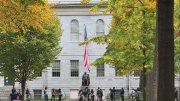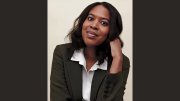If we build it, we lay the groundwork for acts of mass destruction and violence toward mankind. But if we don't build it, we leave ourselves vulnerable, at the mercy of less scrupulous nations and their acts of mass destruction and violence. This, in a nutshell, was the post-World War II debate--top-secret at first, and then explosively public--that occupied everyone from the president of the United States and top physicists to the average American citizen until 1952, when the hydrogen bomb was finally tested at Eniwetok atoll in the Marshall Islands in the South Pacific on November 1 in Operation Ivy.
In the years since, disputes about the H-bomb (or the "Super," as it was sometimes called in its early days) have died down. But in controversies like these, science's relevance to the lives of all human beings becomes clear. And it is these controversies and interactions that Mallinckrodt professor of the history of science and of physics Peter Galison '77, Jf '81, Ph.D. '83, wishes to explore and illuminate.
Long fascinated by the medium of film, Galison considers the documentary a virtually untapped pedagogical vehicle, especially for his own field. (He teaches a course, "Filming Science," along with Arnheim lecturer on filmmaking Robb Moss.) He has found many existing documentaries to be strictly didactic, tilting toward the technical or presenting only one side of an issue. So he set out to make a film that would give viewers enough unbiased information to allow them to form their own opinion about the making of the H-bomb, a subject he had already explored in print.
"There's a way you can get at these issues through film that print can't capture--affect, visual history, place, person, how people speak," he says. In print, he presents the bomb's history as a series of crucial moments. The film, instead, uses interviews, period photographs, and footage from newsreels and television broadcasts to recreate America in the late 1940s and early '50s. (Galison had to have footage of the Eniwetok test declassified before he could view it.)
Ultimate Weapon, which debuted on the History Channel in August 2000, is not, Galison points out, a technical film about the H-bomb. He sometimes jokes that it took longer to make the movie than to make the bomb: production began in 1988, when he and documentary-maker Pamela Hogan '77 began to film people who'd been involved in the H-bomb project. "I knew it was our last chance" for many of them, he says. Some of the most prominent figures were no longer alive--like physicist J. Robert Oppenheimer '26, S.D. '47, who played a crucial role in developing both the atomic and the hydrogen bombs but later had his security clearance revoked and was accused of purposely hindering the H-bomb's production. "People tend to polarize either for or against him," explains Galison. "We wanted to give a more nuanced and complex picture--not make him into a martyred saint [or] a stooge-like devil working against American interests in a nefarious way."
All the world's best physicists were involved in the arms-making community then, Galison says. Edward Teller, one of the most commanding voices in the film, locked horns with Oppenheimer, particularly on the ethical question of whether to pursue research on the H-bomb. (In the film, the physicist Robert Krohn laughingly recalls the day he called Teller into his office to review and sign the patent application for the H-bomb. Teller refused, because the name of mathematician Stanislaw Ulam, Jf '39, was already on the application. "I am the inventor of the thermonuclear bomb!" Teller angrily declared.) To balance Teller's forcefulness, Galison relied on other interviewees and mounds of archival material--including Oppenheimer's papers--to flesh out the latter's side of the story.
By blending science, history, personalities, and even pop culture, Ultimate Weapon illustrates how science becomes intertwined with life. "You can't understand physics taken in isolation," Galison says. "It's connected with our philosophy, with our ways of making war, with our intellectual history. It has shaped those things, but it's also been shaped by those things."
~Elizabeth Gudrais
Peter Galison e-mail address: galison@fas.harvard.edu





